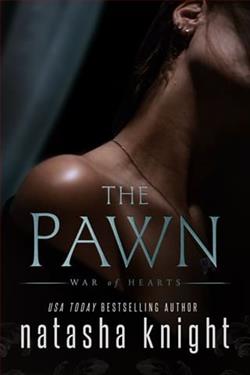Page 18 of The Couple's Secret
As far as Josie knew, no projectiles had been recovered from the car. The bullet casing would have ejected from the gun and landed somewhere in the vicinity of where Tobias had been shot but the bullet itself—the projectile—would have remained inside his head and, like his bones, inside the car. However, if the mandibles and some of the smaller bones had escaped, it was reasonable to think a bullet had as well.
Anya moved to the other table. Snapping on a pair of gloves, she lifted Cora Stevens’ skull and turned it so they could see the back. On the upper right side was a wound different from the one Tobias had sustained but unmistakably from a bullet.
“A keyhole defect,” Josie murmured.
Anya smiled. “Yes, that’s right. We see this when a bullet strikes at a shallow or tangential angle.”
“It’s a graze wound that fractured the skull,” Gretchen said.
“Pretty much, yeah,” Anya said. “In the simplest terms, the projectile glanced off the skull. See this round part? It’s got the same clean, punched-out appearance as the wound on Tobias’s skull—same type of beveling as well. That’s where the initial impact occurred. Then the wound elongates into a sort of wedge shape with the type of external beveling we’d expect to see in an exit wound. Since the force behind the bullet isn’t focused on one direct point at a perpendicular angle, its power is dispersed where the skull curves. It glances off the bone, causing the initial fracture, and then it continues glancing, making this triangle shape. Entry and exit.”
Josie did her best to suppress the shiver that racked her body at the thought of what had happened to her husband last year after he was abducted. While being held captive, he’d received a gruesome graze wound to the head. Luckily the angle had been such that the bullet had broken skin instead of bone.
Gretchen arched a brow. “Not that a skull fracture isn’t serious, but are these keyhole defects normally fatal?”
Anya’s finger traced the contours of the back of Cora’s skull. “No, not always, but they do have a high fatality rate. There are several factors that determine whether this kind of wound is fatal.”
“Like what?” Gretchen pressed.
Josie knew this because of what had happened to Noah, though she wished she didn’t. “Whether the bullet breaches the dura—the membrane that covers and protects the brain.”
“That’s right,” Anya said.
“The location of the injury,” Josie continued. She didn’t even have to close her eyes to imagine the feel of the thick scar tissue along the side of Noah’s head as she ran her fingertips over it. The left temporal lobe was responsible for language comprehension, semantic and auditory processing, verbal memory and the mechanism that allowed you to discern the emotion context in language.
“And how fast you can get proper emergency care,” Josie finished.
“Yes,” Anya agreed. “As you can see, the location of Cora’s injury was to the lower occipital area which is responsible for autonomic processes, two of which are heart rate and respiration. If those were disrupted, she could have gone into cardiac or respiratory arrest. A serious injury in this region could also cause major brain hemorrhaging or even herniation.”
Frowning, Gretchen looked back toward Tobias’s remains. “Someone shot Tobias straight-on in the forehead.”
Anya nodded. “Given the appearance and angle of the wound, it’s more likely that he was standing rather than kneeling. I would estimate that the perpetrator was his height or slightly taller. Or, if he was seated in the vehicle, the perpetrator managed to be level enough to shoot straight-on.”
“And Cora?” Josie asked.
“There are several possibilities.” Anya placed Cora’s skull gently back onto the table. “I’m not sure I can testify in court to any of them without more information, but perhaps she turned or she had started to run away or the perpetrator’s aim was disturbed at the moment the gun was fired.”
Josie didn’t bring up the possibility of murder-suicide. She supposed it was feasible that Tobias had shot Cora, then driven the car into the water and shot himself in the head before the car sank, but it didn’t make sense to her. For one thing, the gear shift had been in neutral, not drive. Second, the angle at which he’d been shot would have been difficult to pull off, especially if he’d been in a vehicle bobbing as it sank into the river. Most people who died by suicide using a firearm put the barrel into their mouths, under their chin, or aimed for their temple. Third, had Tobias meant to kill his fiancée before turning the gun on himself, why go to the trouble of driving into the river? Finally, if that was the case, the probability of Denton PD finding the gun inside the car would have been moderate, at least. Had one been found, Noah definitely would have mentioned it to her.
This was the work of someone else.
“They were both shot in the head,” said Josie. “Murdered in cold blood.”
Ten
It was a flawless crime. Every loose end tied up. Tobias and Cora had been shot execution-style and then the entire car, with them strapped inside, had been pushed into the river three hours from the last place they’d been seen. No traces left behind. In seven years, no one had been able to locate them. Had the drought not been so bad, they would probably still be entombed on the bottom of the Susquehanna. Who knows if they would have been found at all?
Across the exam table that held Cora’s remains, Gretchen met Josie’s eyes. “You thinking what I’m thinking?”
“Based on this alone?” Josie glanced back toward the other table. “Without having seen the Brighton Springs case file? One or both of them were involved with organized crime. Or they saw something they weren’t supposed to.”
“The other possibility is murder for hire.”
“Yes,” said Josie. “This looks a lot like a professional hit.”
Professional killers or people who killed on behalf of a gang or the mafia often used close-range head shots because they were fast and efficient. Very precise. No chance of the victims surviving. That kind of killing was cold and unemotional. Unlike most murders that came from personal disputes.
“Yeah,” Gretchen agreed. “I saw a lot of those when I worked in Philly. Very different from homicides where the killer and victim had a personal connection. Those were usually pretty messy. No organization.”















